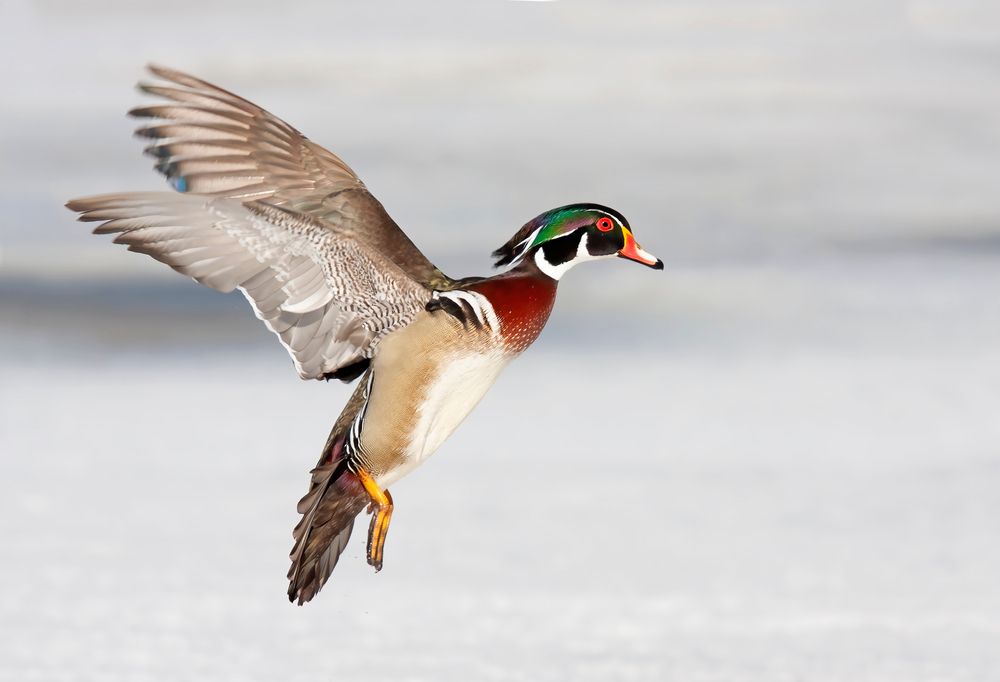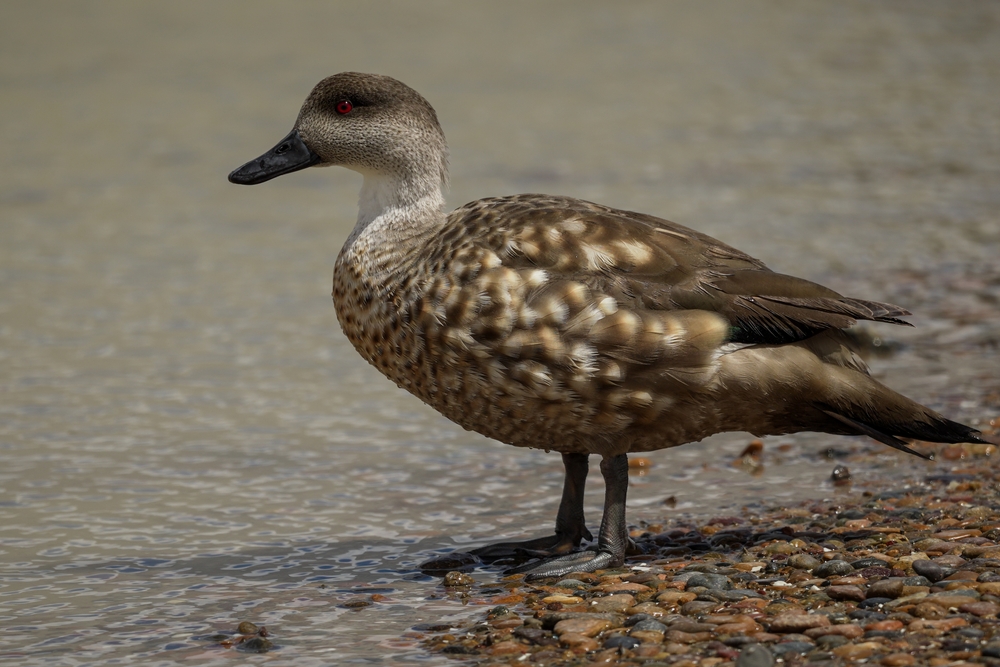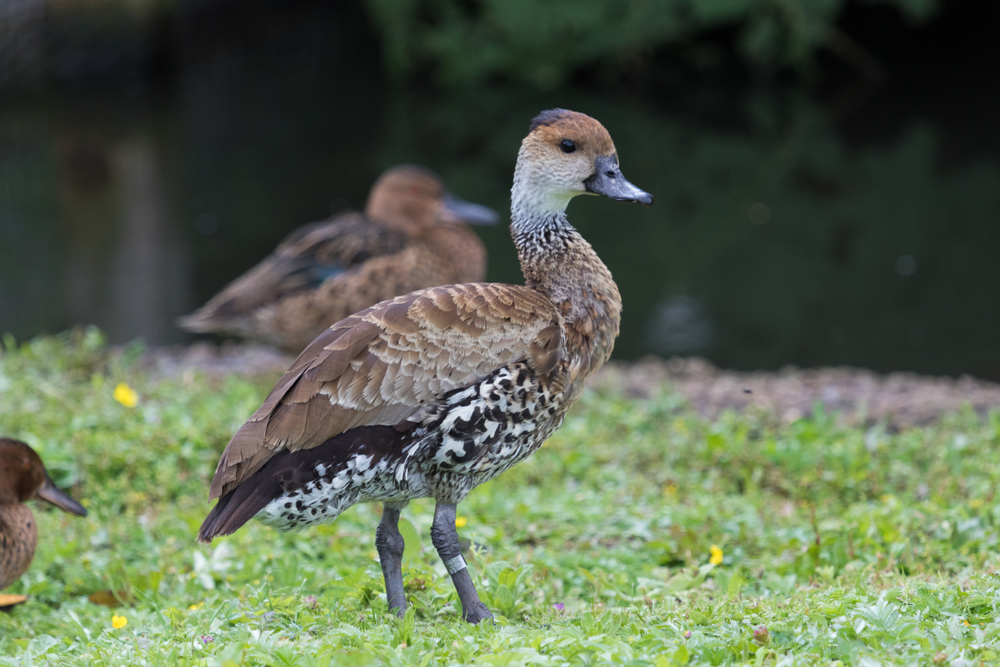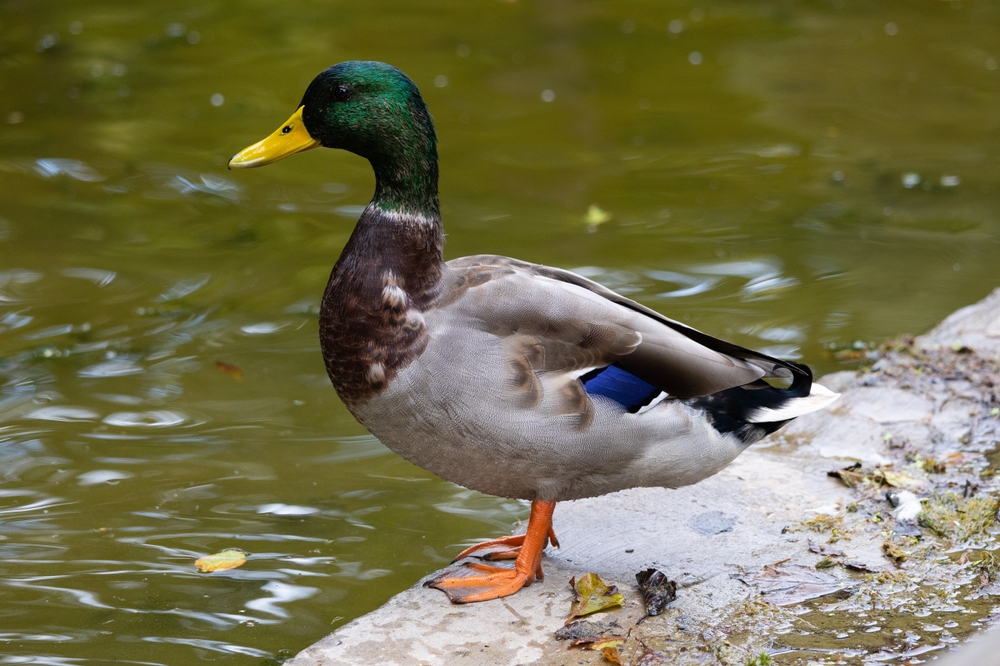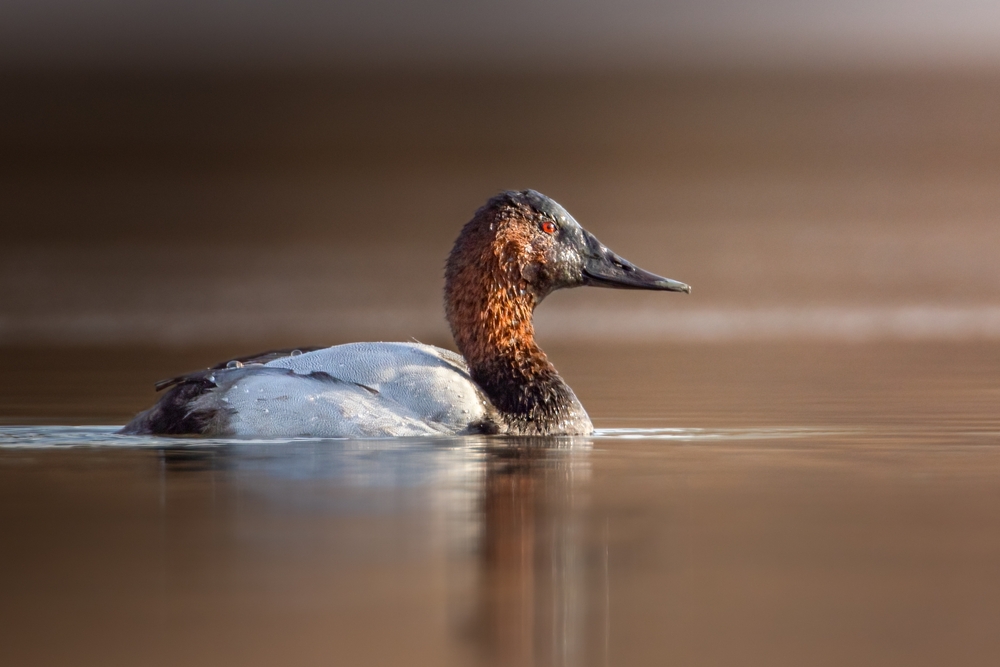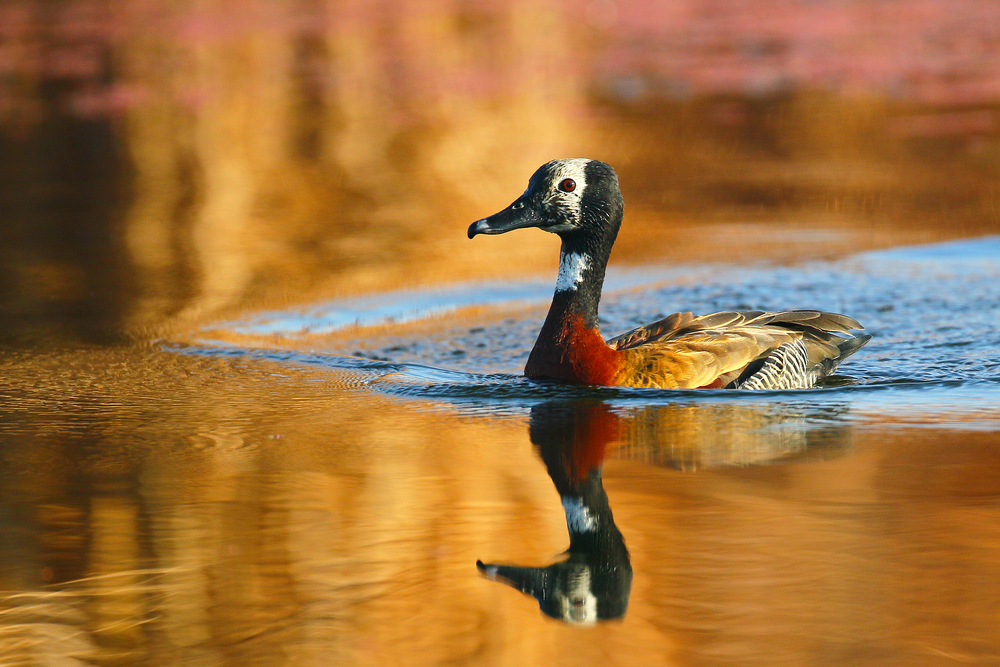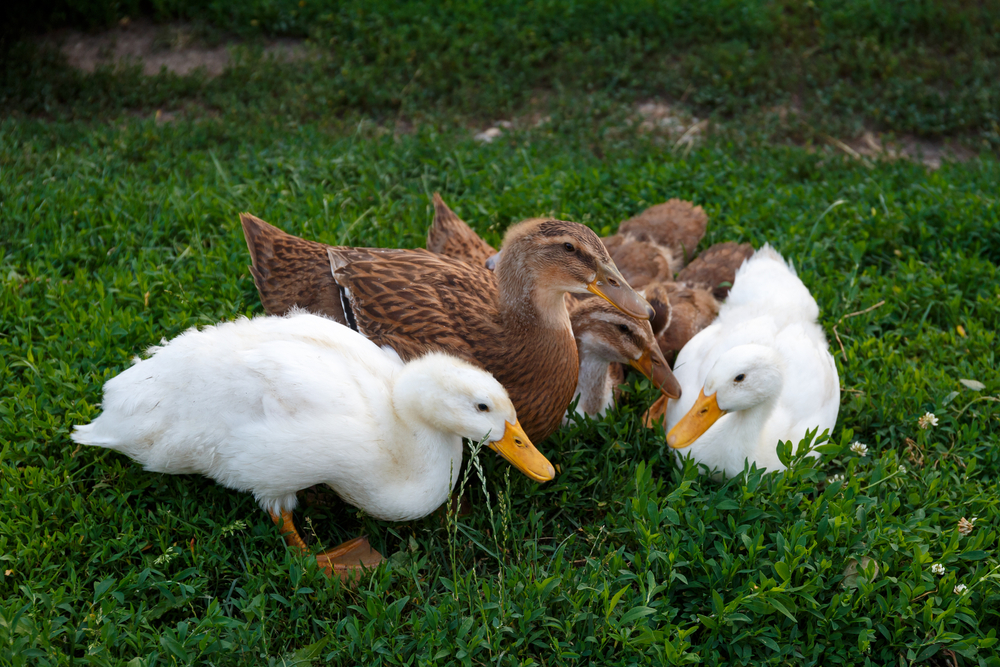Its closest relative is the Mandarin Duck (Aix galericulata) of East Asia. Together, they form the small genus Aix, both tree-nesting ducks with ornate plumage and strong claws for perching.
About
The Wood Duck (Aix sponsa) is one of the most colorful and striking waterfowl in North America, belonging to the family Anatidae. It is native to wooded swamps, marshes, streams, and ponds across the eastern United States, southern Canada, and parts of the Pacific coast. Unlike most ducks, it is a strong tree-dweller, nesting in natural cavities or man-made nest boxes, often high above the ground. Its ability to perch and nest in trees is aided by sharp claws and a more upright posture than many other ducks.
Males are especially dazzling in breeding plumage, displaying an iridescent green and purple head with bold white stripes, red eyes, a chestnut breast, and patterned flanks of buff and black. Females are more subtle, with gray-brown plumage, a white teardrop eye-ring, and blue wing patches, though still elegant. Both sexes show a broad, square tail and a crest at the back of the head. Measuring 47–54 cm (19–21 in) in length with a wingspan of 66–73 cm (26–29 in), the Wood Duck is medium-sized but easily one of the most ornate ducks in the world.
The diet of the Wood Duck is omnivorous, consisting of acorns, seeds, aquatic plants, fruits, and insects. It is particularly fond of oak woodlands, where acorns provide abundant food. Unlike diving ducks, it feeds by dabbling at the surface or grazing on land.
Breeding occurs in spring, with females selecting tree cavities near water. They may also use nest boxes provided for conservation. Clutches usually contain 9–14 eggs, which the female incubates alone. Within 24 hours of hatching, ducklings leap from the nest cavity—sometimes from heights of 50 feet (15 m)—to follow their mother to water, an iconic survival behavior.
Once threatened by overhunting and habitat loss, Wood Ducks have rebounded thanks to conservation measures, protected habitats, and widespread use of nest boxes. Today, they are a thriving symbol of North American wetlands.
Physical Characteristics
The Wood Duck (Aix sponsa) is one of the most colorful and distinctive waterfowl species in North America, known for its ornate plumage and tree-perching ability.
Head & Bill
Males have a glossy green and purple crest with bold white stripes along the face and neck. The bill is short, with red, white, and black markings. Females have a gray-brown head with a white teardrop-shaped eye ring and crest.
Plumage
-
Male (drake): Iridescent green, purple, and blue head; chestnut breast with white spots; buff sides; black back; and striking white throat and neck lines.
-
Female (hen): Mottled gray-brown body with subtle iridescence and a distinctive eye ring.
-
Both sexes: Show iridescent blue speculum patches on the wings, visible in flight.
Body & Posture
Compact, sleek body with relatively long tail and short neck. Known for an upright posture when perched in trees or swimming in shallow wetlands.
Wings
Medium-length, broad wings allow quick takeoff and strong, direct flight.
Tail
Fairly long and squared-off; dark with some iridescent sheen.
Legs & Feet
Strong claws and relatively long toes compared to most ducks—an adaptation that allows perching and nesting in trees. Legs are yellow to orange.
Size
-
Length: 18–21 in (46–54 cm)
-
Wingspan: 26–29 in (66–74 cm)
-
Weight: 1.0–1.5 lbs (0.45–0.7 kg)
The Wood Duck’s dazzling plumage, crested head, and tree-perching habits distinguish it from nearly all other North American ducks, making it one of the most iconic and easily recognized waterfowl species.
Reproduction
The Wood Duck (Aix sponsa) is famous for its tree-cavity nesting and remarkable duckling leaps from high perches. Its breeding cycle is strongly tied to wooded wetlands and riparian forests.
Mating and Courtship
Pair bonds form in late winter to early spring. Males display by raising their crests, bobbing heads, and producing thin whistles. Pairs typically remain together through the nesting season.
Breeding Season
Generally March to July across North America, earlier in the south and later in northern ranges. Some southern populations may raise two broods per year—rare among ducks.
Nesting
The female selects a cavity in a tree near water—often in oaks, maples, or cypress—up to 2–60 ft (0.6–18 m) above ground. She lines the nest with down plucked from her breast. Wood Ducks also readily use nest boxes provided by conservationists.
Eggs
Typical clutch size is 9–14 glossy, cream-colored eggs. In areas with many females, “egg-dumping” (intraspecific brood parasitism) may lead to clutches of 20+ eggs.
Incubation
The female incubates alone for 27–30 days, leaving only briefly to feed.
Chick Development
Ducklings hatch precocial, covered in down with eyes open. Within 24 hours, the mother calls them from the nest. Ducklings leap fearlessly from the cavity entrance—even from heights over 50 ft—and follow her to water.
Fledging and Independence
Ducklings feed themselves but stay under the hen’s protection until fledging at about 56–70 days. Survival rates are heavily influenced by wetland quality and predation pressure.
Special Notes
Wood Ducks’ reliance on tree cavities once caused declines when old-growth forests were logged. Conservation through nest box programs has been a major success story, helping populations rebound across their range.
Lifespan
The Wood Duck (Aix sponsa) has moderate longevity for a medium-sized duck, with survival strongly influenced by predation and habitat quality.
Lifespan in the Wild
Most Wood Ducks live 3–4 years on average, though banding records show some individuals surviving up to 10–12 years. High mortality occurs in the first year, especially during the duckling stage, when predation and weather take a heavy toll.
Lifespan in Captivity
With steady food, veterinary care, and protection from predators, Wood Ducks may live 15–20 years, though they are not commonly kept outside of waterfowl collections or research settings.
Threats to the Wood Duck
-
Predation: Eggs and ducklings preyed on by raccoons, snakes, mink, fish, and raptors; adults vulnerable to hawks and owls.
-
Habitat loss: Removal of mature trees reduces nesting cavities; draining of wetlands limits brood-rearing sites.
-
Hunting pressure: Once hunted heavily for meat and feathers, now managed sustainably with regulations.
-
Weather extremes: Cold snaps, drought, or flooding during nesting season can cause brood failure.
-
Brood parasitism: “Egg dumping” by other hens can overload a nest, reducing hatch success.
Conservation Note
Thanks to habitat restoration, wetland protection, and widespread nest box programs, Wood Duck populations have rebounded strongly in North America, giving many individuals the chance to reach their full lifespan potential.
Eating Habits
The Wood Duck (Aix sponsa) is an omnivorous dabbling duck that feeds in forested wetlands, swamps, rivers, and flooded bottomlands.
Diet
-
Plant matter: Acorns, seeds, aquatic plants, fruits (wild grapes, berries), and agricultural grains.
-
Animal matter: Aquatic and terrestrial invertebrates—snails, insects, beetles, caterpillars, flies, and occasionally small crustaceans.
-
Ducklings: Rely heavily on protein-rich insects and other invertebrates for rapid growth.
Foraging Strategy
Primarily a dabbling duck, tipping up in shallow water to reach submerged seeds and vegetation. Also forages by grazing on land, picking fruits and acorns from the forest floor, and even climbing onto logs or branches to reach food.
Feeding Mechanics
Broad bill with fine lamellae filters food from water and mud. Sensitive bill edges help detect seeds and invertebrates in turbid water.
Daily Rhythm
Most feeding occurs at dawn and dusk, though birds also forage opportunistically during the day in sheltered wetlands or quiet woodlands.
Seasonal Shifts
-
Breeding season: Diet contains more insects and aquatic invertebrates to support egg production and chick growth.
-
Fall and winter: Shift toward acorns, grains, and other seeds, providing the energy needed for migration and cold-weather survival.
Social Feeding
Often feeds in small groups or pairs, though larger flocks gather in rich feeding grounds, particularly in migration and winter.
The Wood Duck’s varied diet and ability to forage in both aquatic and terrestrial habitats make it one of the most ecologically versatile ducks in North America.
Uniqueness
The Wood Duck (Aix sponsa) is one of North America’s most striking and unusual waterfowl, combining dazzling plumage with unique nesting and survival adaptations.
Brilliant plumage
Males are among the most colorful ducks in the world, with iridescent green and purple crests, chestnut breast, and bold white markings. Females show subtler beauty with a distinctive teardrop eye ring.
Tree-nesting duck
Unlike most ducks, Wood Ducks regularly nest in tree cavities, sometimes 60 ft above ground. This unusual habit has driven their strong claws and ability to perch on branches.
Spectacular duckling leap
Ducklings leave the nest cavity within a day of hatching, leaping fearlessly to the ground or water—sometimes from great heights—guided only by the hen’s call.
Two broods per year
One of the few North American ducks capable of raising two broods annually in southern parts of its range.
Nest box success story
Wood Ducks were once in steep decline due to habitat loss and overhunting, but conservation through nest box programs across North America restored populations, making them a conservation icon.
Scientific name meaning
Aix sponsa translates to “waterbird in bridal dress,” reflecting the drake’s ornate, wedding-garment-like plumage.
Habitat versatility
Equally at home in wooded swamps, beaver ponds, rivers, and man-made wetlands, showcasing adaptability to both natural and restored habitats.
The Wood Duck’s mix of brilliant beauty, tree-nesting behavior, and remarkable conservation comeback make it one of the most unique and celebrated ducks in the world.
Be the First to Share Photos of This Species.
FAQ’s
1. What species is closest to the Wood Duck?
2. How does the Wood Duck compare to other ducks?
Unlike most North American ducks, it regularly nests in tree cavities, sometimes high above ground, and its ducklings leap from the nest within 24 hours of hatching. Males are also among the most brilliantly colored waterfowl in the world.
3. What national parks provide the best opportunities for seeing a Wood Duck?
What national parks provide the best opportunities for seeing a Wood Duck?
-
Everglades National Park (Florida, USA) — Wintering and breeding in wooded wetlands.
-
Congaree National Park (South Carolina, USA) — Common in cypress-tupelo swamps.
-
Great Smoky Mountains National Park (North Carolina/Tennessee, USA) — Breeds along rivers and wooded ponds.
-
Cuyahoga Valley National Park (Ohio, USA) — Regular along riparian corridors.
-
Acadia National Park (Maine, USA) — Seen in forested ponds during migration and breeding season.



































































